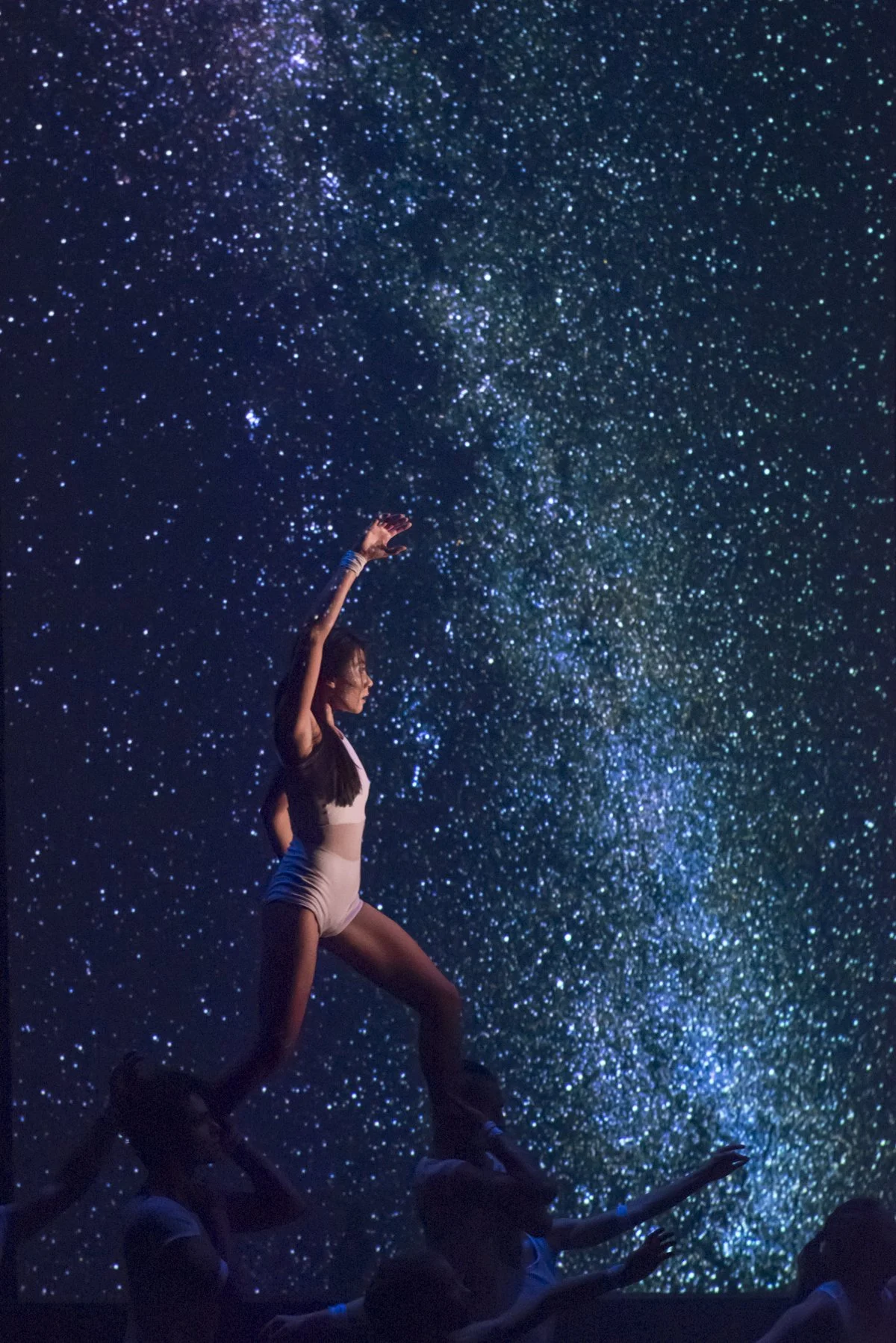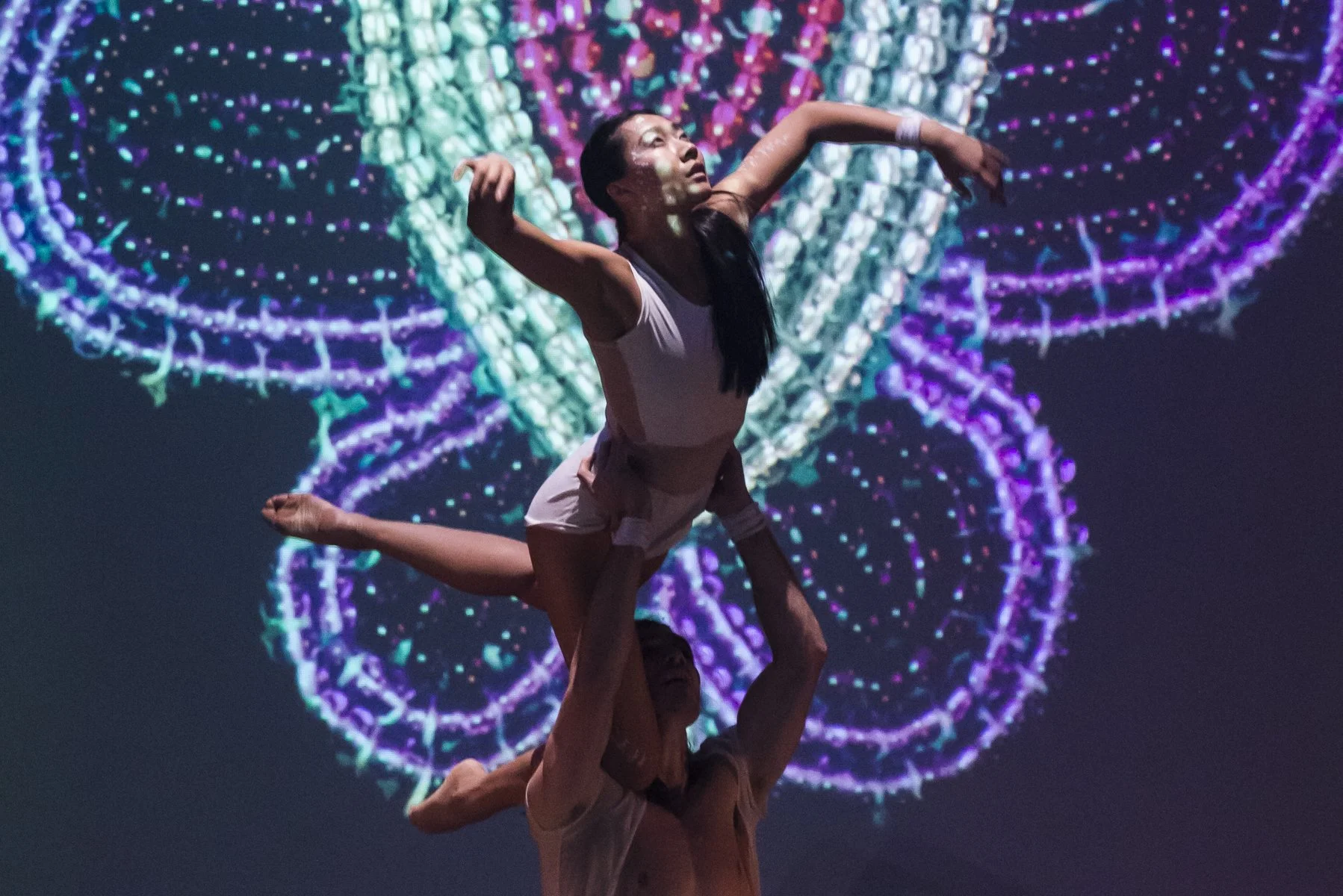Red Sky Performance looks to the night sky through the eyes of the Anishinaabe
A work for six dancers with live music and cosmic visuals, Trace explores Indigenous star stories
Trace by Red Sky Performance. Photo by Rob DiVito
DanceHouse presents Trace by Red Sky Performance, co-presented with SFU Woodward's Cultural Programs, November 24 to 27 at 8 pm and November 27 at 2 pm at SFU Goldcorp Centre for the Arts.
SANDRA LARONDE’S ANCESTRAL name, Misko Kizhigoo Migizii Kwe, means “Red Sky Eagle Woman” in the Anishinaabemowin (Ojibway) language, and the Toronto-based artist is indeed deeply connected to what is above. Throughout her decades-long career, during which she has been hailed as a leader in the revival of Indigenous culture, the executive and artistic director of Red Sky Performance has travelled the globe. No matter where she is on the planet, she makes a point of looking up at the night sky, ever in wonder.
“Whether I’m in Mongolia or New Zealand, it’s interesting how stars look so different,” Laronde says in a phone interview with Stir. “It makes me feel connected. When I look up at the stars, I can feel that there’s something that the rational brain can’t comprehend. For the Anishinaabe, the Milky Way is the path of souls, the river of souls where people return home. We believe we come into the world from there and go back there.
“I think about that pathway or portal to another dimension, and it’s inspiring to think that human beings and the ingredients of a star are very similar in their alchemy,” she says. “We truly are the stuff of stars.”
The origin story of the Anishinaabe people inspired Trace. Contemporary Indigenous company Red Sky Performance brings a full-length work to Vancouver to close a six-week, 15-city tour across Canada and the U.S.
Laronde, who is of the Teme-Augama-Anishinaabe (People of the Deep Water) in Temagami, northern Ontario and is now based in Toronto, wanted to share the Indigenous perspective of the stars with the work. Consider the mythological figure of Geezhigo-Quae (Sky Woman), a powerful being who is said to have lived above the clouds and, upon falling to Earth, laid the groundwork for the beginnings of life. It is perplexing to Laronde how, in this place called Canada, when most people look skyward, they will point out constellations like Orion’s Belt or spot planets such as Jupiter. With those astral names, people are telling Greek and Roman stories. Why aren’t Indigenous tales and legends being carried on?
“So often, star stories are very essential stories; they are stories of a psyche of a people,” Laronde says in a phone interview with Stir. “So as Canadians, we are really learning more about the cultural psyche of the Greeks and Romans than as who we are as Canadians. I was really interested in knowing more about that Canadian struggle to know who we are. If it’s not reflected back to ourselves through stories that spring from this land, this sky, this point of view, how could we ever know who we really are?
“That’s why we create art,” says Laronde, former director of Indigenous Arts at the Banff Centre for Arts and Creativity. “We need that. Trace is really about letting Canadians know about Indigenous astronomy, our way of looking at the night sky and what it means to us.”
Trace by Red Sky Performance. Photo by Rob DiVito
Set against a backdrop of graphic projections by Marcella Grimaux evoking humanity’s existence from single atom to expansive cosmos, Trace creates a starry universe with an Indigenous-influenced percussive soundscape by composer Eliot Britton, a member of the Manitoba Métis Federation. The score will be performed live by three musicians and interspersed with recorded throat-singing vocals of Orla Barlow-Tukaki and Nelson Tagoona and the dancers’ own rhythmic breathing. Propelling the full-length work for six dancers is highly physical choreography by Red Sky Performance associate artist Jera Wolfe, a Toronto-based dance artist of Métis heritage.
Local audiences had a taste of Trace this past spring, when Digidance presented the virtual broadcast of More Than Dance, We Are A Movement, a Red Sky Performance retrospective. The company’s upcoming performance markets the first time it has been on a Vancouver stage in over a decade. Laronde says her company only became busier during the pandemic, with inquiries from all over the world for digital collaborations. Trace won two Dora Mavor Moore awards in 2019 for outstanding choreography and outstanding sound design and composition.
Laronde’s wish for Trace is that audiences to leave feeling better informed and more inspired.
“I hope people walk out feeling lifted, feeling awestruck, by the theme and by the incredible artistry,” Laronde says. “I want people to look up at the night sky and start thinking about what lives up there, to look at the world differently.
“Art is focused on the soul and really helps people in that spiritual side of things,” she says. “It helps people feel connected and to wonder about things.”
For more information, see DanceHouse.















